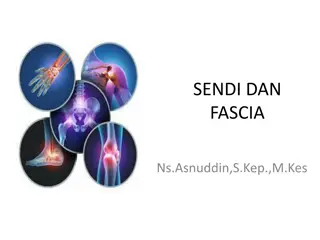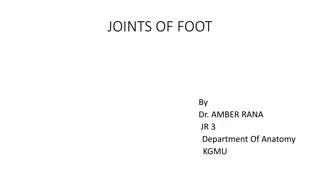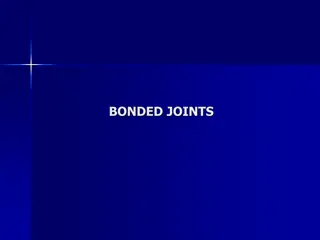Understanding the Complex Structures and Functions of Joints in the Hand
The hand complex consists of 19 bones and 19 joints distal to the carpals, with each digit having specific joints that facilitate movement and flexibility. Detailed descriptions of CMC joints, MCP joints, and the role of ligaments and accessory structures in enhancing stability are provided, shedding light on the intricate workings of the hand's functionality.
Download Presentation

Please find below an Image/Link to download the presentation.
The content on the website is provided AS IS for your information and personal use only. It may not be sold, licensed, or shared on other websites without obtaining consent from the author. Download presentation by click this link. If you encounter any issues during the download, it is possible that the publisher has removed the file from their server.
E N D
Presentation Transcript
THE HAND COMPLEX DR. DIGVIJAY SHARMA DEPARTMENT OF PHYSIOTHERAPY U.I.H.S KANPUR
THE HAND- The hand complex consists of 19 bones and 19 joints distal to the carpals. There are 5 digits or 4 fingers and 1 thumb. Each digit has a carpometacarpal (CMC) joint and a metacarpo- phalangeal (MCP) joint. Each fingers have 2 interphalangeal joint and the thumb has only one.
STRUCTURE OF FINGERS- CMC JOINTS The CMC joints are composed of articulation between the distal carpal row and the bases of 2nd to 5th metacarpals. The proximal portion of 4 metacarpals of fingers articulate with distal carpal to form the 2nd through 5th CMC joint The 2nd metacarpal articulates with trapezoid primarily and secondarily with trapezium and capitates. The 3rd articulate with capitates . The 4th articulate with capitates and hamate And 5th metacarpal articulate with hamate. Each of Metacarpal also articulate at its base with the contiguous metacarpal. All CMC joint are supported by a strong transverse and weaker longitudinal ligament Volarly and dorsally.
FUNCTIONS- CMC joint from 2nd to 4th are plane synovial joint with 10 of freedom flexion/extension. The 2nd and 3rd are essentially immobile and may be considered to have 00 of freedom. The 4th have perceptible movement while 5th is a saddle joint with 20 of freedom, Flexion/extension, abduction/adduction and a limited amount of opposability.
MCP Joints of the Fingers- These are joint formed by articulation between the convex metacarpal head proximally and the concave base of the first phalanx distally. It is of condyloid type with 20 of freedom, flexion/extension and abduction/adduction . The large MC head has 1800 of articular surface which is opposed to approximately 200 of articular surface of the phalanx. The joint is surrounded by a capsule that is considered to be lax in extension and allows some passive axial rotation in this position.
The joint is incongruent because of difference in its articular surface so their must be an accessory structure to enhance stability, which is served by the volar plate. The volar plate is an unique structure at MCP joint that increases joint congruence. It is composed of fibro cartilage and is firmly attach to the base of the proximal phalanx. The plate becomes membranous proximally to blend with the capsule.
The capsule is also strengthen by 2 collateral ligament. The collateral ligament of MCP joint are slack in extension permitting full range of abduction/adduction. They are considered in close pack position when the joint are in full flexion and permitting minimal amount of abduction/adduction. This is more because of bony block rather than tension in collateral ligament.
Range of motion- The R.O.M. available at MCP joint varies with each finger. The flexion/extension increases radially to ulnarly with the index finger having approx. 900 of MCP flexion and little 1100. The abduction/adduction is maximal when the joint is in the extension and minimal in full flexion.
IP Joints of the Fingers It consist of head of the proximal phalanx and the base of the distal phalanx to it . It is a true hinge joint with 10 of freedom. The joint Is strengthen by a joint capsule, a volar plate and collateral ligament. ROM The total ROM of flexion and extension available at PIP joint (1000- 1100) is greater than DIP joint (800). The radially to ulnarly and reaches to 1350 and 900 respectively.
STRUCTURE OF THUMB- CMC JOINT- It is the articulation between the trapezium and base of the 1st metacarpal. It is a saddle joint with 2 degree of freedom. Flexion/Extension Abduction/Adduction The joint also permits some axial rotation. The CMC joint surface consist not only of the traditionally described saddle shaped surfaces but also of a spherical portion. The saddle shaped portion of the trapezium is concave in sagittal plane (abduction/adduction) and convex in frontal plane (flexion/extension).
The spherical portion is convex in all direction. The base of 1st metacarpal has a reciprocal shape to that of the trapezium. Flexion/extension and abduction/adduction occurs on the saddle shape surface, where as axial rotation that accompanies opposition occurs on the spherical surface. Flexion and Extension occurs nearly parallel to the palm around a oblique AP axis and adduction/abduction nearly perpendicular around oblique coronal axis. This obliquity of motion occurs because of inclination of the trapezium. The capsule of CMC joint is relatively lax but is reinforced by radial, volar and dorsal ligaments. The CMC joint ROM as an average of 530 of flexion/extension, 420 of adduction/abduction and 170 of rotation.
FUNCTION OF 1ST CMC JOINT The unique range and direction of motion at the 1st CMC produces opposition of the thumb. The opposition is sequentially, abduction, flexion and adduction of the 1st metacarpal. The functional significance of the CMC joint is appreciated when thumb is used against a finger in almost all forms of prehension.
MCP and IP Joint of Thumb The MCP joint is the articulation between the head of 1st metacarpal and the base of its proximal phalanx. It is condyloid type of joint with 20 of freedom : flexion/extension and abduction/adduction. The IP joint of the thumb is the articulation between the head of the proximal phalanx and the base of distal phalanx. It is structurally and functionally identical to the IP joint of finger. The main function of MCP is provide to additional flexion range to the thumb in opposition and to allow the thumb to grasp and contour to the object. Despite the structural similarities the ROM at 1st MCP is for more restricted then finger MCP joint.
Although the ROM varies among individuals the 1st MCP rarely has more than flexion available at fingers and little finger and little if any hyperextension. Adduction/abduction and rotation is extremely restricted. This limitation is because of the structural difference between the 1st MCP and other MCP joints. The first MCP joint is reinforced intra capsularly on its volar surface by two sesamoid bones. These are maintained in position by collateral fibers and inter sesamoid ligament.
PREHENSION It is defined as holding or grasping of an object between any two surfaces in the hand. The thumb participates in most but not all prehension activity. Prehension is categorized as :- 1. Power Grip 2. Precision handling
Power Grip:- Power grip is the result of a sequence of opening the hand, positioning the fingers, approaching the fingers to the objects and maintaining a static phase that actually constitutes the grip. It is generally a forceful act resulting in flexion at all fingers joint. When the thumb is used it acts as a stabilizer to the object held between the finger and the palm. The power grip can be categorized as- Cylindrical Grip I. Spherical Grip II. III. Hook Grip IV. Lateral Prehension
Cylindrical Grip:- This Grip exclusively uses flexors to carry the fingers around and maintain grasp on an object. The function especially in dynamic closing action is performed mainly by flexors digitorum profundus. The FDS assists when greater force is required in the static phase. Traditionally power grip was considered as an extrinsic activity but recent studies have shown and considerable involvement of interosseus muscle activity.
In strong grip the magnitude of force of the interossei in MCP flexion has been found nearly equal that of the extrinsic flexors. The interossei may also position the MCP joint in adduction or abduction to ulnarly deviate the MCP joint and align the distal phalanges of thumb and fingers. The joint compression of joint stability during power grip is enhanced by active or passive contraction of Extensor Digitorum Communes. The thumb usually comes around the object then flexes and adducts to close the object.
The Flexor Pollicis Longus and the thenar muscles are all active. The Extensor Pollicis Longus may be variably active as an MCP stabilizer or as an adductor. In cylindrical grips the wrist is in neutral flexion and extension and slight ulnar deviation. The heavier the object more likely it is that the wrist is ulnarly deviated. Regardless the position of the wrist. The percent of total IP flexor force allocated for each finger is relatively constant. The ring and little finger can generate only 70% of flexor force of the middle and index finger. The contribution of little finger can be increased in an object that is wider ulnarly than radially.
SPHERICAL GRIP- The main distinction between spherical and cylindrical grip is greater spread of the finger to encompass the object. So it requires more interossei activity compared to other power grip. MCP joint do not deviate in the same direction but tend to abduct. The phalanges are not parallel to each other. The MCP abductors must be joined by the adductors to stabilize the joint which is in semi flexed position. Other activities are same as cylindrical grip. Although the flexor activity predominate, the extensors do have their role in providing a balancing force for the flexor and also essential for smooth and controlled opening of the hand and release of the object.
HOOK GRIP- It is included in the power group because it has more characteristics of power grip than precision handling. It is a function primarily of the fingers. It may include the palm but never include thumb. It can be sustained for prolonged period of time as anyone carrying briefcase. The major muscles that is working are FDP and FDS. If the load is carried more distally so the DIP function is required the FDP must participate and if it is carried more in the middle Phalanx the FDS is sufficient. The interossei is also active but exact function is not known. The thumb is held in the moderate to full extension by the thumb extrinsic.
Lateral prehension- it is a unique form of grasp in which contact occurs between two adjacent fingers. The MCP and IP joints are usually remains in the extension as the contiguous MCP joint simultaneously abduct and adduct. This is the only form of prehension in which extensors plays a part in maintenance of the posture. The EDC and Lumbricals are active to extend the phalanges. The MCP abduction and adduction is performed by interossei.
It is included in power grip because it involves the static holding of the object and then moved by the more proximal joint of upper extremity although not a powerful grip neither it is used to manipulate the object in the hand. Example- holding cigarette
Precision Handling- It is the skilful placement of an object between fingers or finger and thumb. The palm is not involved. Precision handling does not contain a static phase of the grip, here the fingers and thumb grasp the object with intention of manipulating it within hand, Whereas in power grip the object is grasp so that it can be moved through space by the more proximal joints. Precision handling in contrast to the power grip requires much fine motor control and are more dependent on intact sensation In a 2 jaw chuck, the thumb is 1 jaw while the second and opposing jaw is formed by either the distal tip, the pad or the side of a finger. Here, the thumb is generally abducted and rotated from the palm when two fingers oppose the thumb it is called a Three Jaw Chuck
Types of precision handling- 1.Tip to Tip 2.Pad to Pad 3.Pad to Side
Pad to Pad Prehension- It involves the opposition of pad or pulp of the thumb to the pad or pulp of the finger. 80% of precision handling uses this mode of prehension, where mainly the pad of the distal phalanx of each digit is used. If it is 2 jaw chuck usually index finger is used and in three jaw chuck the middle finger added. The MCP and PIP joint of fingers are partially flexed, with the degree of flexion depends upon the size of object being held. The DIP joint may be fully extended or in slight flexion. The DIP extension is caused by the pull of the FDS down on the middle phalanx against the pressure of thumb on the distal phalanx. When the partial DIP flexion is required by the task, the FDP must be activated. MCP flexion and MCP adduction or abduction, which is required for the manipulation of object is provided by interosseus. In a dynamic manipulation, the palmer and dorsal interossei work reciprocally while in a firm pad to pad pinch they may co-contract. The thumb is held in CMC flexion, abduction and rotation.
The MCP and IP joints are partially flexed to fully extended. These activity of the thumb is assisted by thenar muscles. In full extension of finger DIP and thumb IP contacts occur on the proximal portion of the distal phalanx. As the flexion increases the contact moves distally towards the nails. The extensor muscles is used for opening the hand to grasp, for release and for stabilization when necessary. The wrist is held in neutral, radial/ulnar deviation and slight extension.
Tip to tip prehension- In this the IP joint of the finger and thumb are nearly fully flexed. The MCP of finger must be a ulnarly deviated to the prevent the tip of the finger to the thumb. In first finger the ulnar deviation occurs as an adduction while in other as abduction. The muscular activity required for tip to tip prehension is same as pad to pad prehension and additionally it requires activity of FDP, the FPL and the interossei. Although these muscles may assist in pad to pad prehension but not required.
Pad to Side prehension- It is also known as key grip because a key is hold between the pad of the thumb and side of the index finger. It is differ from the other forms of precision handling in that the thumb is more adducted and less rotated. The activity level of FPB and adductor pollicis increases and that of the opponences pollicis decreases as compared with tip to tip prehension or pad to pad prehension. Slight flexion of the distal phalanx of the thumb is required. it is the least precise form of precision handling and it can actually perform by the person with paralysis of all hand muscles. if this prehension is used for turning a key the wrist will assume neutral flexion/extension and drop into slightly ulnar deviation to put key in line with the forearm so that pronation and supination is used to turn the key.
Functional position of the wrist and hand- WRIST COMPLEX- Slight extension (20 ) Slight ulnar deviation (10 ) FINGERS- MCP joint moderated flexed (45 ) PIP joint = slightly flexed (30 ) DIP joint = slightly flexed























